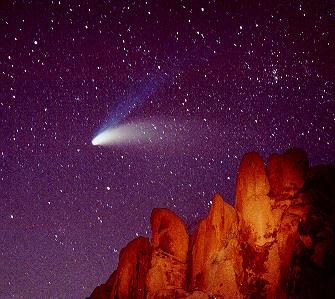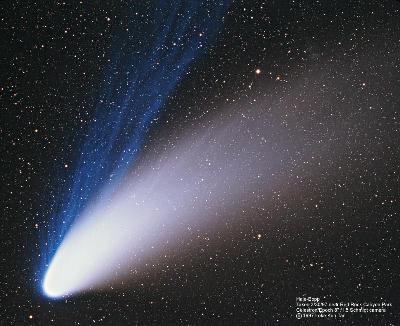| |
 |
| |
Image
of Comet Hale-Bopp taken by Wally Pacholka
on April 5, 1997 from the Joshua Tree National
Park in California.
|
On July 23, 1995, an unusually bright comet outside
of Jupiter's orbit (7.15 AU!) was discovered independently
by Alan Hale, New Mexico and Thomas Bopp, Arizona.
The new comet, designated C/1995 O1, is the farthest
comet ever discovered by amateurs and appeared
1000 times brighter than Comet Halley did at the
same distance. Normally, comets are inert when
they are beyond the orbit of Jupiter, so it has
been speculated that Comet Hale-Bopp is either
a rather large comet or experienced a bright outburst
(or both). The comet was the brightest comet since
Comet West in 1976. From Hubble Space Telescope
images, the comet's diameter has been determined
to be about 40 km. The Pic du Midi Observatory
has ascertained from their observations that the
comet's rotation rate is 11.4 hours.
 |
|
Comet
Hale-Bopp image taken by Loke Kun Tan on March
30, 1997 from the Red Rock Canyon Park in
California.
|
|
Comet Hale-Bopp made its closest approach to
Earth on March 22, 1997 at a distance of 1.315
AU (1 AU = 93 million miles or 150 million km).
It reached perihelion (closest distance to the
Sun) on April 1, 1997 at 0.914 AU. The comet did
not pass particularly close to either the Sun
or the Earth, but because of its rather large
size, the comet was very bright and reached a
peak magnitude of about -1. In fact, Comet Hale-Bopp
was at magnitude 0 or brighter for an astounding
8 weeks, the longest ever recorded for a comet.
Also, Comet Hale-Bopp holds the record for the
longest period of naked eye visibility, an astoninshing
19 months, easily breaking the the previous record
of 9 months held by the Great Comet of 1811.
| Last updated
November 26, 2003 |
|
